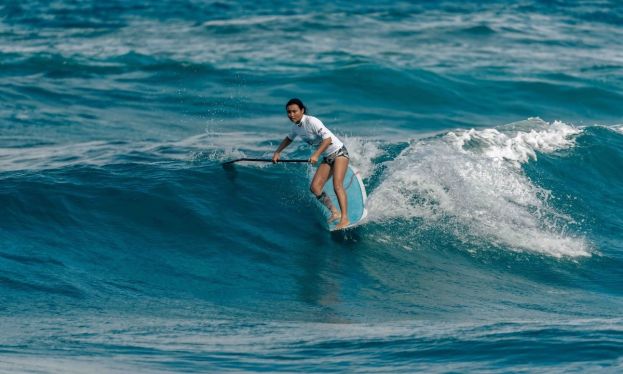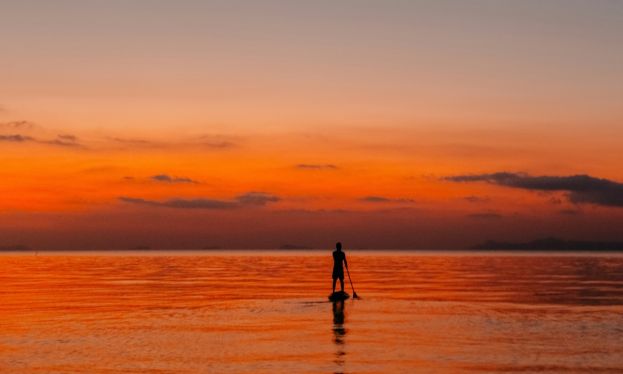10 Intermediate Tips For Organizing Great SUP Races
- Written by Andre Niemeyer
- Published in Tips
- Comments::DISQUS_COMMENTS
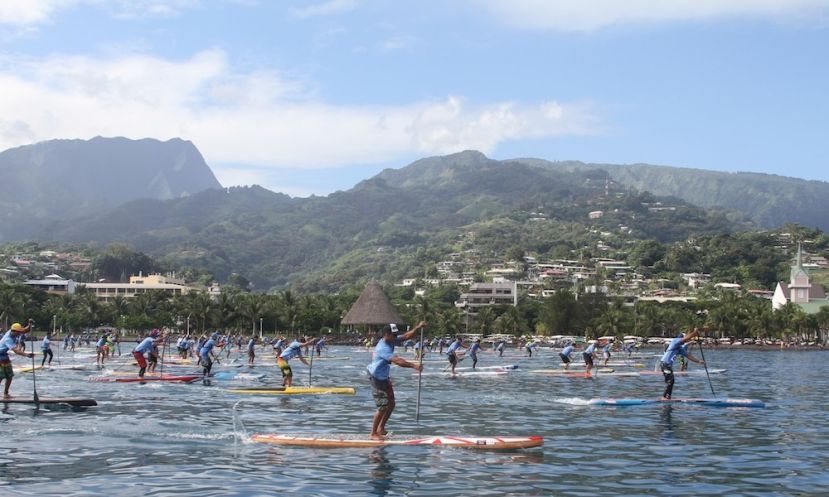 2015 Air France Paddle Festival. | Photo: Allie Brown
2015 Air France Paddle Festival. | Photo: Allie Brown
SAN DIEGO, California - Here are a few extra steps that can help take your event to a whole new level. It’s important to note, however, that these extra steps can have a major impact on the overall success of your event, ranging from funding and attendance to promotion and beyond. All the steps below serve as a highly important layer to the 10 Basic Tips for Organizing SUP Races. So, here are the intermediate tips for sup race organizing in no particular order.
1. Try Your City or Department of Tourism for Sponsorship
Several cities (and sometimes even countries) offer all sorts of subsidies to offset the costs of your event. Local communities have an invested interest in seeing you succeed. More visitors to your town and/or country mean more money spent in your local businesses and more wealth generated for your friends and families. Municipalities typically don’t have a lot of budget, but can offset costs of permits, collaborate with your event on promotion, and open all sorts of doors to help you better execute the sup race. Some countries even have large budgets to deliver high-profile productions. Check with your City Council or Department of Tourism to see whether there are any available resources to assist with the sup race event organizing. Several high-profile events have benefited from these programs, including the Standup Paddle World Series and Tour in various locations, Master of the Ocean in the Dominican Republic, and more. The point being: don’t be shy or hesitate. You won’t know whether there are funds allocated if you don’t ask. Remember that the success of your event can have highly positive implications for your community, not only you.
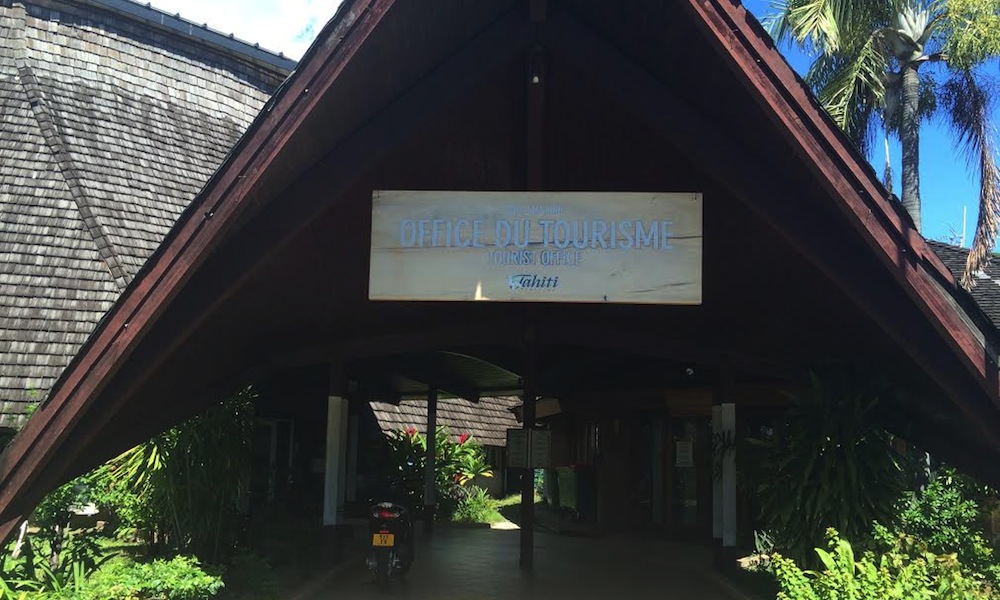 |
 |
The Air France Paddle Festival in Tahiti is just one event that works with the Dept. of Tourism for their event. | Photos: Allie Brown
2. Reach out to Local News, Groups, and Other Events
As a participant, there is nothing less motivating than attending a sup race where only competitors are present on hand. Competitors and your business partners want to experience the roar and cheers of the crowd, feel the energy of the throngs of people on the beach, and ultimately paddle with the support of the masses. There are far too many events – especially high-profile ones – where event organizers do a great job reaching out to the core community to participate while missing out on the deluge of spectators that could have come from the local community. Residents look forward to happenings in their areas. So reach out to local media, attend other events and pass out fliers, put up posters on local coffee shops and stores. Give a chance for the local residents to attend and check out the action. That’s just plain good business practice. Next year they may be your competitors and their children the world’s next paddle superstars!
3. Add Your Event to Calendars like Supconnect & Supracer
It’s free! … or at least most of them are free. Supconnect and Supracer’s calendars are free and are among the leading sources for finding stand up paddle events locally and around the world. Supconnect’s SUP Event Calendar draws from over 1,100 events, including not only sup races but all sorts of sup events, from surf contests and yoga retreats to river races and beyond. Supracer is the go-to blog for stand up paddle racing. Reach out to Chris Parker and ask to have your event featured. Also, contact your local paper, visit meetup groups, and send a message to bloggers that may have an interest in the event. Here are some of the websites where it’s usually free to post events:
- Supconnect.com
- Supracer.com
- Supthemag.com
- Paddleguru.com
- Distressedmullet.com (US, East Coast)
- Paddledates.com (Australia)
- Forumdesup.com (France)
- Eatonsurf.com (California, West Coast)
- StandupPaddleMagazin.com (France and EU)
- SupCurrents.com (Northern California)
- ABSup.com.br (Brazil)
- Supclub.com.br (Brazil)
- Supsa.org.za (South Africa)
- NZsup.org (New Zealand)
- Paddlefaster.net (Florida)
- WetfeetHawaii.com (Hawaii)
- Standuppaddle.com (USA)
If we missed a website, email info@supconnect.com
4. Decide on Food: Lunch boxes, Catering, or Vendors
Understand the targeted participant, how much it’s usually spent on such events, and make the call from there. For instance, if targeting a high-participation turnout, there will likely be lots of paddlers who have participated in other events. And that means spending very little money on food. Lunch is normally around $10/person, with some events providing free catering courtesy of a local restaurant. In that case, there will likely be a backlash if you decide to charge $25/person for food. Now that may not be a problem if targeting a higher-income, more educated demographics, not heavily comprised of core paddlers. In this case, which may be a fundraiser of sorts, $25/person or more could well fit the bill. In most events, either food vendors, lunch boxes, or a local restaurant sponsoring the catering will do.
Be mindful that attendees at stand up paddle events are health-conscious and like organic, seasonally grown foods. Don’t be shy to throw brownies and cookies in there as well. There will be plenty of sugar-starved paddlers craving for chocolate after their meals. And as always, have plenty of hydration with water, gatorades, coconut water, etc. Big jugs everywhere with all of these are key to prevent paddlers from feeling sick. Don’t forget to place trash cans everywhere and aim at leaving the place cleaner than you found it.
5. Remind All Volunteers to be Cheerful Greeters
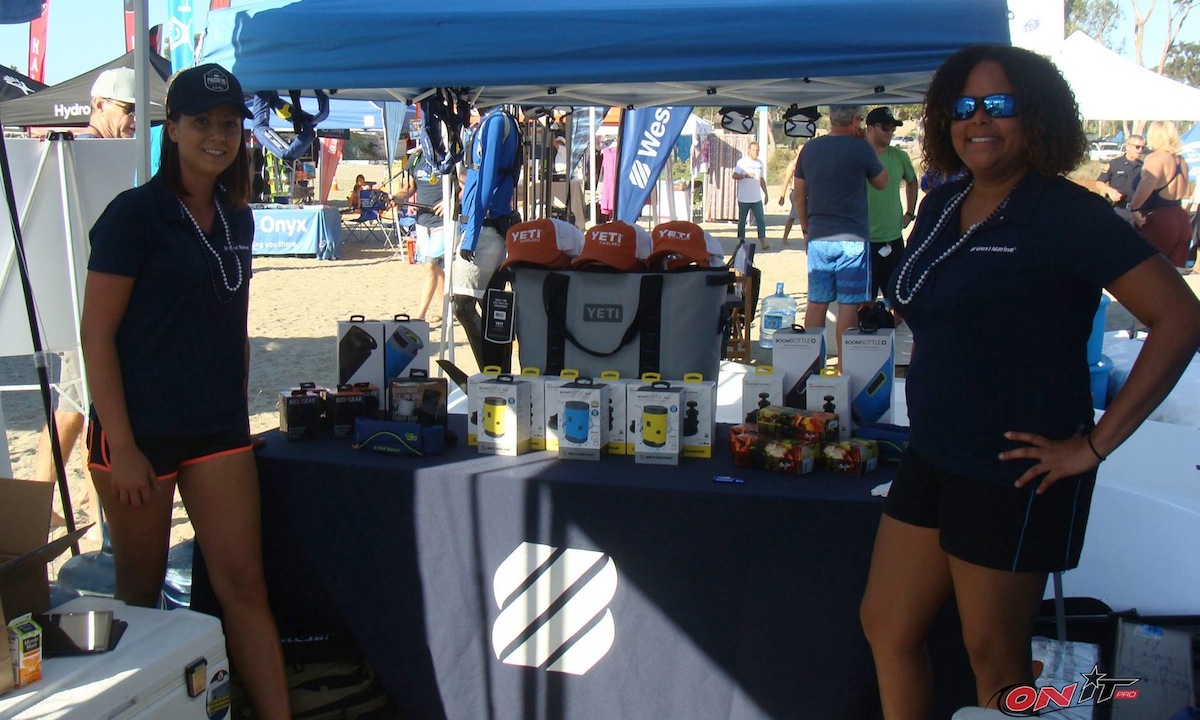 Everyone loves a friendly smile! | Photo: OnitPro
Everyone loves a friendly smile! | Photo: OnitPro
There is nothing worse than a grumpy event volunteer and/or staff. Whoever is in charge of logistics, identify your entire chain and every touch-point possible with attendees and train, train, train event workers to have the biggest smile in the world. Sometimes, it’s not even an event volunteer. For instance, the event may be partnering with an adjacent hotel, which is donating its parking structure. But the worker at the booth is mean and knows nothing about the discount price for parking. That alone could ruin someone’s experience. It’s not theory: it has happened many times. Some event organizers have created a “Chief of Experience” position, so as to ensure that at every touchpoint there is a great experience and, sometimes, even a great surprise.
CLICK HERE to see more SUP Racing Tips.
6. Designate a Place for Safe Board Staging
Standup Paddle Boards are large and not easy to handle. Have a gameplan for attendees to unload them from their cars and for getting the equipment to a safe area near the shoreline. This is sometimes called the “Board Stage Area.” Now some of these boards cost several thousand dollars. So the area must be safe, obviously. Find yourself some trustworthy volunteer-bouncers and have them guard the equipment at all times. In case of a multi-day event, hire security guards. The former Battle of the Paddle, the Race of the Lake of the Sky, and other sup races have all created safe board stage areas with hired security guards, so participants could have peace of mind and avoid the hassle of hauling the board back-and-forth from one day to the other.
7. Have Really Nice Trophies and Prize Bags
Trophies matter! … prize bags and raffles, too. People who are likely to win or aspire to win want something pretty to showcase their achievement. Nice trophies help set an event apart and offer all the more incentive for paddlers to aim for top finishes. It’s not only true of adults, but also all the more true of kids. Children are at a pivotal moment in their life where they can choose from a plethora of activities and sports. Having a nice trophy or medal hanging on the shelf can go a long way to making the sport “sticky” for generations to come.
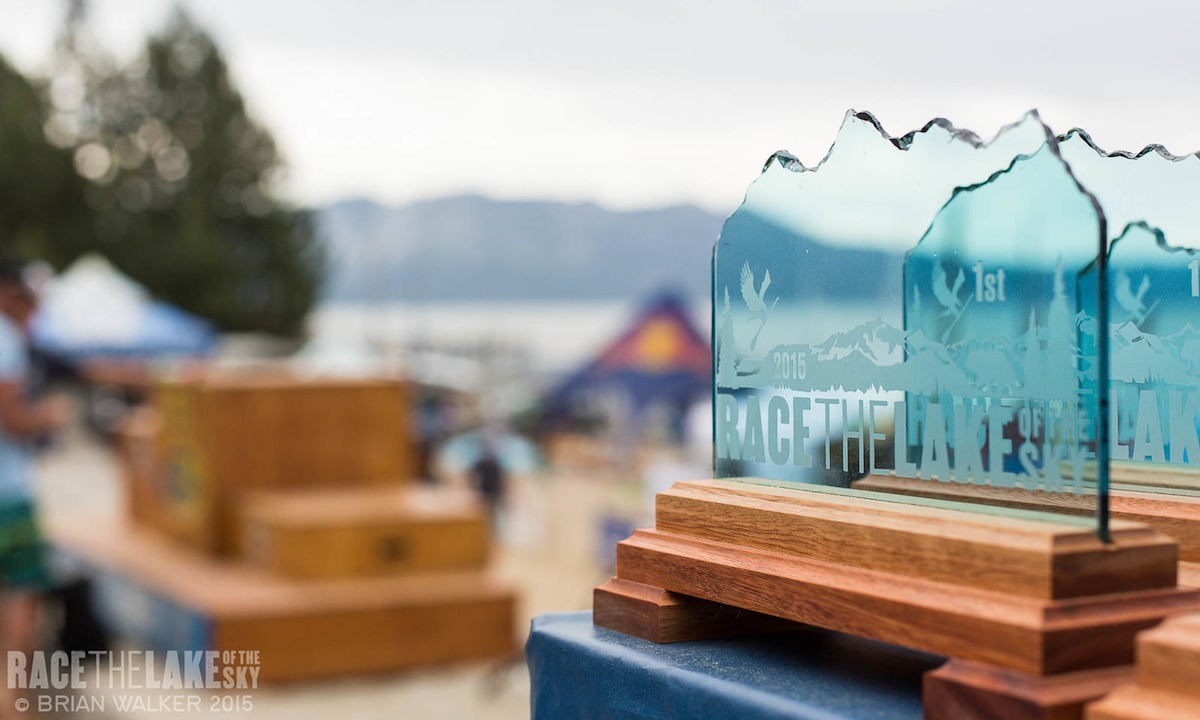 Race the Lake of the Sky is one event that has some really nice trophies! | Photo: Brian Walker
Race the Lake of the Sky is one event that has some really nice trophies! | Photo: Brian Walker
There are tons of “Awards” and “Trophy” stores, online and locally, with trophies in all price points, from plastic and wood to glass and crystal. Local, high-end carpenters can also create some of the most beautiful trophies ever. Don’t break your budget here but have at least a medal for every kid participating, a really nice trophy for the top finishers, and nice prize bags. Other items that can add a lot to the event is a “lifetime event monument,” where the names of the top finishers are edged into it with plaques for the year of the achievement. Raffles can also add lots of fun to the event. Now be careful not to run the awards ceremony too long and late. Competitors are exhausted and eager to rest!
8. Create Sponsorship Deck for Vendors
Vendors add appeal to the SUP event and help offset costs. Create a vendors village, with companies that align with your attendee’s demographic. Standup paddle racers are into health, equipment, travel, and such. But think creatively. For instance, Standup Paddle For the Cure, a fundraiser to help fight breast cancer, which started in Southern California, has a Vendors’ Village with both endemic and non-endemic vendors, some of which are there simply to add value, like the local hospital or doctor offering free skin-cancer screening for the sun-bathed crowd. Over the years, they’ve been able to spot several attendees with various forms of skin cancer and help them to treat it, arguably even saving some people’s lives. In the broad swath of endemic and non-endemic prospect vendors, think big and add value. In doing that, it’s essential to have a sponsorship deck with slides talking about the event, race formats and activities, sponsorship tiers and deliverables. Once in its second annual, the deck can be updated with objective participation, attendance, and media coverage statistics.
Event sponsorship tiers normally range from Platinum, Gold, Silver and Bronze. Higher tiers come with thorough logo placement on website, t-shirts, … and banners while the lower tiers come with booth space at the very least. Vendor’s booth space should cost between $100-500, with some free spots for vendors like the local hospital. Higher profile events sometimes charge as much as $2,000-$5,000 per booth space. Study the sup-event landscape, identify the scope of your event, and charge proportionally. You want the sponsors to come back next year.
 Vendors add appeal to the SUP event and help offset costs. | Photo: OnitPro
Vendors add appeal to the SUP event and help offset costs. | Photo: OnitPro
9. Post Race Course on Website and Have Pre-race Meetings
Keep it simple and communicate it clearly. Competitors are jacked up on adrenaline, distracted by all the people around, and usually very nervous. It’s the perfect recipe for miscommunication. Build too complex of a course and be ready for wrong buoy turns, rule violations, and all kinds of havoc. Spend time to draw the race course, paddle it and measure it before hand. Here are some tools:
- Use Google Earth to draw and measure sup race course
- Paddle sup race course with GPS device to experience it
- Post screenshot of Google Earth race course on website
- Draw race course on whiteboard for pre-race meeting
If you want to take it up a notch, print out the course into foam boards and place them on stands near the registration area, so athletes can spend time preparing for the race and memorizing their turns. To make it even fancier, create a video using Google Earth and add a voiceover giving prospect paddlers insights on the different turns and nuances of the stand up paddle race course.
Create a video with voiceover introducing the course. For this, follow the steps below:
- Trace course using Google Earth Desktop Version
- Play course within Google Earth
- Screen-record course play using Quicktime
- Place Quicktime source file into iMovie
- Add voiceover, render video, and upload it to Youtube
- Embed it on the course landing page of the website
Additionally, have clear rules and a special word on sportsmanship. More often than not, violations are not to the express rules, but to the spirit of sportsmanship. It’s pivotal that race directors do their utmost best to protect the integrity of the sport and its cheerful, welcoming culture. Too often, race directors “let it slide” to avoid being controversial. If that’s the case, have a different race director. Controversies happen, willing or not. It’s important to be proactive and aggressive to ensure there is nothing short of excellent sportsmanship, so others will be encouraged (not discouraged) to participate.
10. Note Numbers and Boards at Finish Line
 Notice the 3 volunteers in red shirts at the finish line of the Race the Lake of the Sky. | Photo: Sean Davis
Notice the 3 volunteers in red shirts at the finish line of the Race the Lake of the Sky. | Photo: Sean Davis
Some racers register for one board class but race using a different board. If the event has distinct board classes (like 12’6”, 14’, and under 12’6” in board length), someone registering for the under 12’6” class and racing on the 14’ has an obvious advantage. I, for one, have been a victim of this injustice. After registering for the under 12’6” board class, I found myself coming second to a paddler on a 14’ race board. To my credit, he was within reach. But nonetheless, that’s not the point. He ended up winning and I came second. In this case, it wasn’t a big deal: for I’m a good sport … at least in that instance, for I was at a fundraiser. But instances like this could undermine one’s motivation to participate in the following year. So, have at least three volunteers at the finish line (assisted by others near start and buoy turns) to ensure that everyone has a fair start, rounds all buoys, and competes with boards in their board classes.
At registration, have the competitor’s number clearly displayed on body, jersey and board, certifying that the board in question is for the registered class. Then have volunteers at the finish line calling out and verifying numbers at the finish line. One person as time keeper, another calling out the number of paddlers crossing finish line, and a third person with a spreadsheet jotting it all down. That should do it. If you have the budget, time keeping companies can take it to the next level, with monitors at finish line, immediate online result updates, and more.
In addition to the 10 Basic Tips for Organizing SUP Races, these 10 Intermediate Tips should help you to make your event that much better.
Did we miss anything? What else do you think can greatly improve SUP races?
Andre Niemeyer
Andre Niemeyer is Supconnect's Publisher, founding president of the Standup Paddle Industry Association, and an expert SUP surfer. He has a strong background in competitive longboarding and has competed and won some of the early sup surfing events in mainland US.
Website: supconnect.com Email This email address is being protected from spambots. You need JavaScript enabled to view it.
